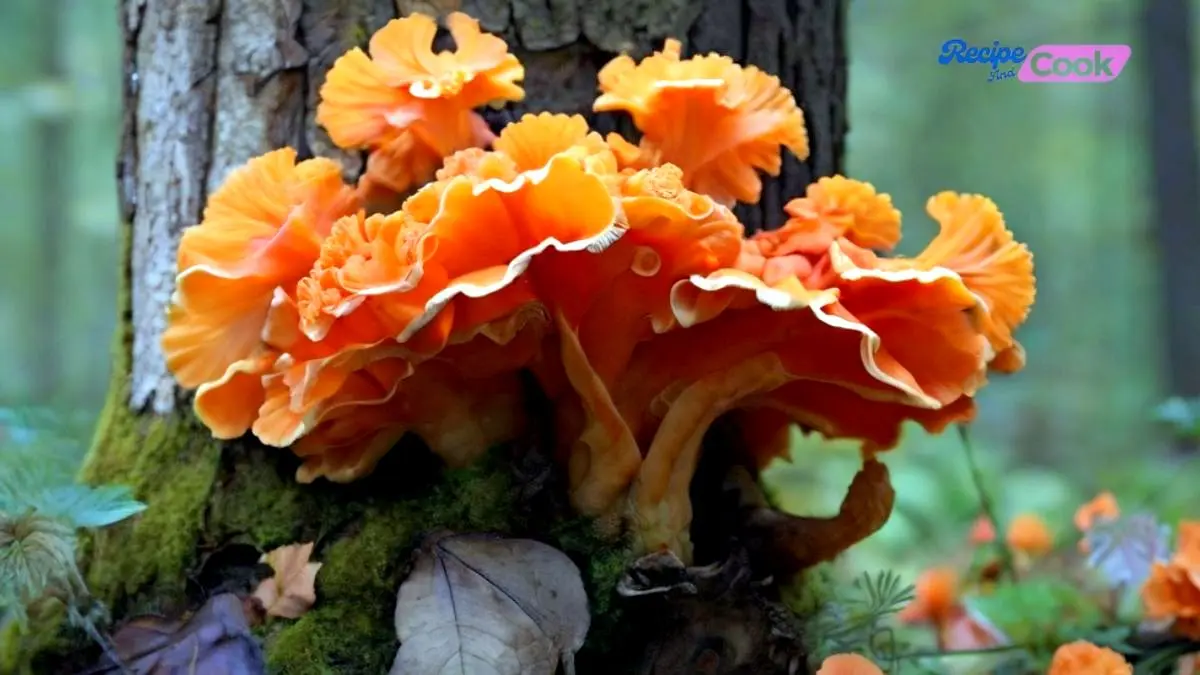Foraging for wild mushrooms can be an exciting and rewarding experience, and one of the most coveted finds in the world of mycology is the Chicken of the Woods.
This strikingly vibrant fungus is not only visually appealing but also a choice edible for many mushroom enthusiasts.
In this comprehensive guide, we’ll delve into everything you need to know to identify Chicken of the Woods, its habitat, and how to safely enjoy this culinary delight.
What is Chicken of the Woods?
Chicken of the Woods, scientifically known as Laetiporus species, is a bracket fungus that typically grows on dead or dying hardwood trees.
The name “Chicken of the Woods” comes from its texture and flavor, which some people say resembles chicken meat.
This mushroom is known for its vibrant colors, which can range from bright orange to yellow and creamy white at the edges.
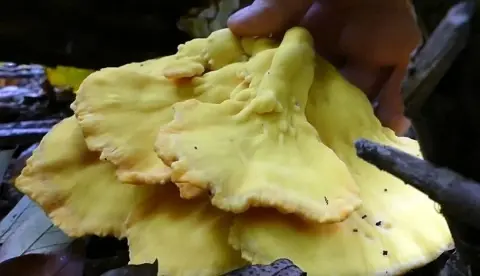
When and Where to Find Chicken of the Woods
Chicken of the Woods usually appears in the summer and autumn months, although it is rarely found during the winter and spring. This fungus is commonly found throughout North America, Europe, and Asia.
In North America, it can be found from Canada down through the United States. However, different species of Laetiporus are found on either side of the Rocky Mountains.
You can typically find Chicken of the Woods growing in clusters on the trunks or bases of dead or dying hardwood trees, with oak being the most common host. It can also grow on other deciduous trees such as cherry, beech, and chestnut.
Identifying Features of Chicken of the Woods
Chicken of the Woods stands out with its vibrant orange and yellow coloring and its distinct shelf-like, bracket formation. Its firm, fibrous texture and tiny yellow pores on the underside are key characteristics to look for.
Color of Chicken of the Woods
One of the most distinguishing features of Chicken of the Woods is its color. The top surface of the mushroom is a bright orange that can sometimes be so vivid it appears almost fluorescent.
The edges of the fungus are usually a paler yellow or creamy white. These colors can help you spot the fungus from a distance, especially when it’s growing in large clusters.
Shape and Size of Chicken of the Woods
Chicken of the Woods has a distinct shelf-like appearance, often forming semi-circular brackets that overlap each other.
These brackets can range in size, but a good tree can yield over 20 kilograms (up to 50 pounds) of this mushroom. Individual brackets can be up to 24 inches across, making them quite noticeable.
Texture of Chicken of the Woods
The texture of Chicken of the Woods is firm and somewhat fibrous, similar to that of cooked chicken, which is how it gets its name. When young, the flesh is soft and tender, but it becomes harder and more brittle as it ages.
Pores of Chicken of the Woods
Unlike gilled mushrooms, Chicken of the Woods has pores on its underside. These pores are tiny and often yellowish, which is another key feature to help with identification.
Safety and Edibility of Chicken of the Woods
While Chicken of the Woods is considered a choice edible by many, it’s important to exercise caution:
Allergic Reactions: Some individuals may experience allergic reactions or gastrointestinal upset after consuming Chicken of the Woods. It’s advisable to start with a small amount to see how your body reacts.
Proper Identification: Ensure you have correctly identified the mushroom. Chicken of the Woods does not have many look-alikes, but it’s always best to cross-reference with a reliable guide or consult with an experienced forager.
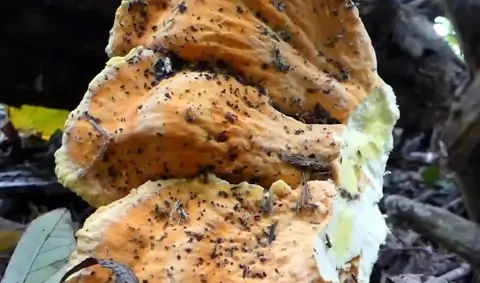
Preparation: Clean the mushroom thoroughly before cooking. Due to its texture, Chicken of the Woods is excellent for frying, sautéing, or incorporating into stews and stir-fries. Cooking it well helps in breaking down any potential toxins.
Harvesting Chicken of the Woods
When harvesting Chicken of the Woods, here are a few tips to ensure you get the best quality:
1. Timing: Harvest young and tender specimens. Older mushrooms can be tough and woody.
2. Tools: Use a knife to cut the brackets off close to the base. This helps in preserving the tree and allows for potential future growth.
3. Cleanliness: If the mushrooms are dirty, brush them off gently. Avoid washing them until you’re ready to cook, as they can absorb water and become soggy.
For more details, please read after harvesting, How to Clean Chicken of the Woods?
Watch the following video for better understanding
Culinary Uses and Chicken of the Woods Recipes
Chicken of the Woods is highly versatile in the kitchen, offering a unique flavor and texture that can be used in a variety of dishes. It have several health benefits, Explore the Benefits of Eating Chicken of the Woods.
Here are some delicious ways to prepare and enjoy this wild mushroom:
1. Chicken of the Woods Pasta: Slice the mushroom into thin strips and sauté with garlic, olive oil, and a splash of white wine. Toss with your favorite pasta and top with Parmesan cheese and fresh herbs for a simple yet flavorful dish.
2. Sautéed Chicken of the Woods: Simply sauté the mushroom in butter with a pinch of salt and pepper until golden brown. Add some fresh herbs like thyme or rosemary for extra flavor. This can be served as a side dish or used as a topping for steaks or salads.
3. Chicken of the Woods Hash Browns: Grate the mushroom and mix it with shredded potatoes, a beaten egg, and some chopped onions. Form into patties and fry in a hot skillet until crispy. These hash browns make a great breakfast side or a unique addition to any meal.
4. Chicken of the Woods Jerky: Slice the mushroom into thin strips and marinate in a mixture of soy sauce, maple syrup, and smoked paprika. Dehydrate in a food dehydrator or oven until chewy. This jerky makes a tasty and protein-rich snack.
5. Chicken of the Woods Risotto: Cook a creamy risotto and stir in sautéed Chicken of the Woods towards the end of cooking. The mushroom adds a wonderful meaty texture and depth of flavor to this classic Italian dish.
6. Chicken of the Woods Tacos: Sauté the mushroom with taco seasoning and use as a filling for soft or hard-shell tacos. Top with fresh salsa, avocado, and a squeeze of lime for a delicious and meat-free taco option.
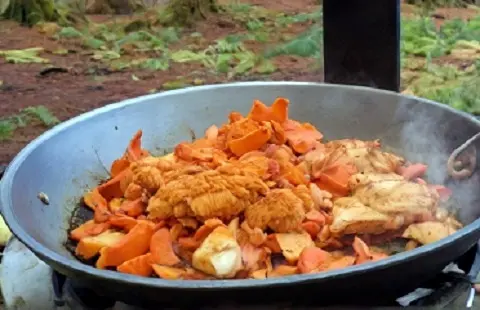
7. Chicken of the Woods Pizza: Top a pizza crust with tomato sauce, mozzarella cheese, and thinly sliced Chicken of the Woods. Bake until the crust is crispy and the cheese is melted. Finish with a drizzle of truffle oil for an extra gourmet touch.
8. Chicken of the Woods Soup: Add chunks of the mushroom to a vegetable or chicken broth along with your favorite soup vegetables. Simmer until everything is tender. The mushroom imparts a rich, savory flavor to the soup.
9. Chicken of the Woods Omelets: Sauté the mushroom with some onions and bell peppers, then fold into a fluffy omelets with cheese. This makes a hearty and satisfying breakfast or brunch dish.
10. Chicken of the Woods Stir-Fry: Combine sliced Chicken of the Woods with a mix of colorful vegetables and stir-fry in a hot wok with soy sauce, ginger, and garlic. Serve over rice or noodles for a quick and nutritious meal.
These culinary uses of Chicken of the Woods showcase the mushroom’s versatility and its ability to enhance a wide range of dishes. Whether you’re making a simple sauté or a more elaborate meal, Chicken of the Woods can add a unique and delicious flavor to your cooking repertoire.
FAQs on This Identifying Process
Here are some commonly asked questions and their short answers on this blog. People has asked many questions like Are Chickens of The Woods Good to Eat? and we have got you covered in this section.
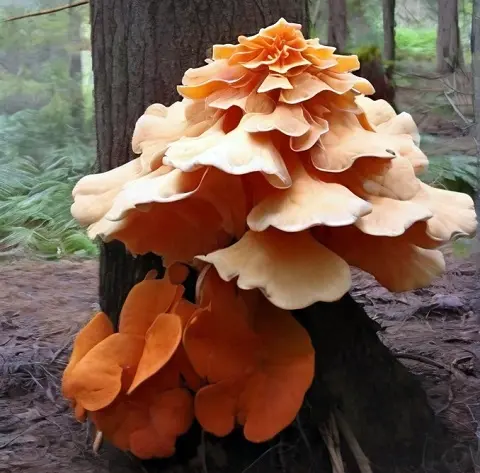
1. How do you tell if you have Chicken of the Woods?
You can identify Chicken of the Woods by its bright orange top surface and pale yellow or creamy white edges. It grows in semi-circular, shelf-like brackets on dead or dying hardwood trees, and the underside has tiny yellowish pores.
2. Does Chicken of the Woods have look-alikes?
While Chicken of the Woods is relatively distinctive, it can sometimes be confused with other bracket fungi. However, its bright colors, firm texture, and the yellow pores on its underside help distinguish it from most other fungi.
3. Is Chicken of the Woods easy to find?
Yes, Chicken of the Woods is relatively easy to find due to its bright coloration and tendency to grow in large clusters on hardwood trees, particularly in the summer and autumn months.
4. What causes Chicken of the Woods to grow?
Chicken of the Woods grows on dead or dying hardwood trees. The fungus thrives by breaking down the wood, which provides it with nutrients. It often appears after periods of rain when moisture levels are high.
5. Is Chicken of the Woods edible?
Yes, Chicken of the Woods is considered a choice edible mushroom. It has a texture similar to chicken and can be prepared in various ways, such as frying, sautéing, or adding to soups and stews. However, some people may experience allergic reactions or gastrointestinal upset, so it’s advisable to try a small amount first.
6. What does Chicken of the Woods taste like?
The taste of Chicken of the Woods is often described as resembling chicken or having a lemony flavor. Its firm, meaty texture makes it a popular substitute for meat in various recipes.
7. Where is Chicken of the Woods commonly found?
Chicken of the Woods is commonly found in North America, Europe, and Asia. In North America, it grows east of the Rocky Mountains on hardwood trees like oak, beech, and chestnut.
8. When is the best time to harvest Chicken of the Woods?
The best time to harvest Chicken of the Woods is during the summer and autumn months when the mushrooms are young and tender. Older specimens can become tough and woody.
9. Can you grow Chicken of the Woods at home?
While it is possible to cultivate Chicken of the Woods at home, it requires a specific growing environment that mimics its natural habitat, including the presence of hardwood logs or stumps for the fungus to colonize.
10. How do you prepare Chicken of the Woods for cooking?
To prepare Chicken of the Woods, clean the mushrooms thoroughly to remove any dirt or debris. Slice them into strips or pieces, then cook by frying, sautéing, or adding to soups and stews. Cooking well helps break down any potential toxins and enhances its flavor.
Chicken of the Woods is a vibrant, delicious, and easy-to-identify mushroom that can be a delightful addition to your foraging finds.
By familiarizing yourself with its distinctive characteristics, growth habits, and preparation methods, you can safely enjoy this wild edible.
Always remember to forage responsibly and sustainably, ensuring that these natural treasures can be enjoyed for generations to come.
Feel free to share your experience with this recipe by trying it out. Don’t forget to drop a comment and provide your feedback on the blog for us to read.
Additionally, You can also like and, follow us on Pinterest, and Reddit for more updates. Your thoughts and engagement are greatly appreciated!

